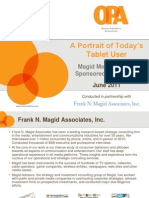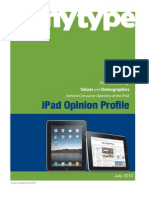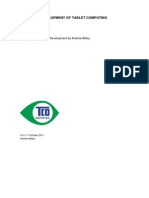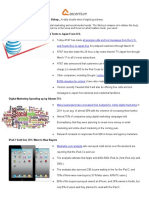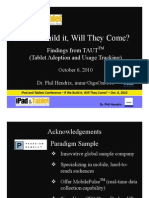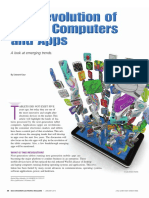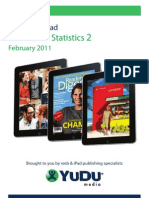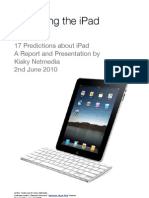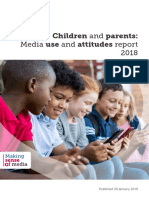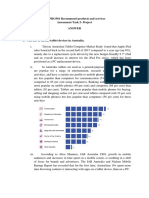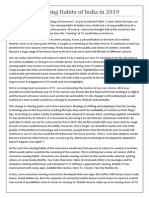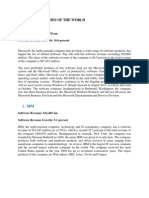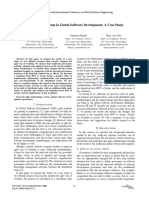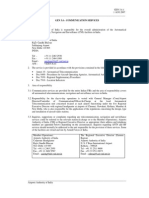DISCOVERY RESEARCH: VIDEO PERCEPTIONS STUDY
JANUARY 2012
iPad Owners Offer a Glimpse Into Future Behavior
Over one thousand Discovery Viewers were surveyed about their media habits and thoughts concerning advertising in the digital age. The study sought to explore how adoption and usage of new devices and platforms is impacting consumers relationship with content and acceptance of advertising. Additionally, our study focused on iPad owners to see what the habits of early adopters can teach us about the ever-changing media landscape and provide some early indications of changes to come
While the iPad is still owned by a relatively small portion of the US population, it is estimated by 2014, there will be 61 Million iPad users in the US, representing nearly 19% of the US population. Currently the iPads core user base skews towards technology adopters (young males and those in upper income brackets), however, adoption by the early majority and ultimately the masses is expected to evolve quickly. iPad owners are exploring new ways of consuming media of all types on their tablets and therefore potentially point to how future behavior may shift among the mainstream population over time.
�DISCOVERY RESEARCH: VIDEO PERCEPTIONS STUDY
Currently own/subscribe to
DVD pl a yer (wi thout recorder) MP3 pl a yer/i Pod Ga mi ng cons ol e HD TV Set Ha ndhel d ga mi ng devi ce DVR DVD recorder Sma rtphone HD-DVD/Bl u-Ra y pl a yer Sa tel l i te ra di o Netbook eRea der Ma c l a ptop computer Roku, Appl e TV, Sl i ngbox 3-D TV Ma c des ktop computer Googl e TV
2
iPad Owners
81% 89% 78% 87% 48% 64% 41% 82% 63% 34% 31% 40% 47% 26% 12% 31% 8%
iPad ownership is certainly indicative of early adoption, as one quarter of iPad owners also cite that they own a Roku, Apple TV or Sling Box (vs. 10% of the non-iPad owners). Not surprisingly, 87% of iPad owners have a HD TV set and 64% own a DVR (vs. 45% of the non-iPad owners. When looking at the future of media consumption, and how marketers and advertisers can successfully reach those who are changing their behavior as new devices emerge, we can look to current iPad users to see what is driving their media usage: The answer is simple video.
Non iPad Owners
76% 78% 67% 72% 35% 45% 29% 56% 39% 20% 17% 19% 20% 10% 4% 10% 2%
% Diff
7% 13% 17% 20% 37% 40% 43% 47% 59% 76% 80% 112% 133% 158% 179% 199% 310%
Our research shows that iPad owners are voracious video viewers, consuming decidedly more video content (2/3rds of iPad owners watched 10+ hours of video on alternative devices in a week) than non-iPad owners. iPad owners are also much more likely (+86%) than non-owners to watch 20+ hours of video on devices other than TV in a week.
One might think, given the above finding, the iPad is simply taking away from Television viewing. However our study reveals that it is seemingly helping to increase TV viewership as iPad owners are much more likely to watch conventional TV (in addition to other video viewing) for longer periods of time than those without tablets.
�DISCOVERY RESEARCH: VIDEO PERCEPTIONS STUDY
Currently 73% of our sample report they use their laptop to surf the net while watching the tube and over a third of respondents claim to use their smartphone or desktop to go online while watching TV. Our research, however, shows that we can expect to see dramatic changes as the iPad becomes more mainstream.
Already ranking second to laptops, the iPad/tablet was cited as the #1 device respondents were planning to purchase during the next 12 months. This adoption will likely be further fueled by the slated release of the iPad 3 in early 2012. It is important to note that respondents do not foresee replacing their laptop or PC with the iPad anytime soon (only 4% of respondents cited that due to their iPad they no longer use them). Consumers currently view the iPad primarily as an entertainment device rather than a device used mostly for shopping or work - two major time uses for the traditional laptop/desktop. There is clearly a need for both devices in users lives.
�DISCOVERY RESEARCH: VIDEO PERCEPTIONS STUDY
Which of the following statements apply to your use of the iPad? I primarily use it as a entertainment device I do not forsee replacing my laptop/desktop with my iPad I share the iPad with other members of my household I am comfortable making purchases on my iPad I use my laptop/desktop less since I acquired my iPad I use the iPad as a gaming device I am more likely to make purchases on my laptop/desktop than on my iPad I am the only one who uses the iPad in my household I primarily use my iPad for work I dont mind advertisements on my iPad I am wary of making purchases on my iPad I am more likely to click on advertisements on my iPad then I am online and/or using my smartphone I solely use my iPad (and other wireless devices) and no longer use a laptop/desktop
% of Respondents 74% 63% 52% 45% 39% 38% 38% 28% 17% 16% 15% 13% 4%
43% of iPad owners claim to watch TV & go online all or most of the time while only 33% of non-iPad owners claim the same
The iPad further differentiates itself from usage on other devices as 52% of tablet owners are sharing their devices. More portable than a laptop, less personal than a smartphone; the iPad has created a niche that bridges the two devices. As a portable sharable entertainment device, the iPad serves to fill content spaces not covered by the other myriad of devices in peoples lives. When asked how often they watch TV and go online simultaneously, 43% of iPad owners claim to do both all or most of the time while only 33% of non-iPad owners claim the same.
This claim is further supported by hourly traffic (pageviews) to our own Discovery Channel iPad app. As illustrated in the chart below, the highest traffic is delivered between 8-11pm, when primetime is in all its glory. Comparing
�DISCOVERY RESEARCH: VIDEO PERCEPTIONS STUDY
hourly traffic to our DiscoveryChannel.com website delivery shows their peak traffic is from 1-2pm (work time lunch surfing/ typical web prime time).
Overall, the tablet provides the same flexibility and utility as other mobile devices/ smartphones as nearly 3 out of 4 say they use their tablet while lying in bed. In addition to using their devices throughout the entire house, our data shows that tablets are becoming increasingly important as a companion to supplement TV viewing. A sizeable group (41%) of iPad owners cited that they use the device to further extend their TV experience to do various activities including looking up/posting/chatting about what they are watching on TV. When Tablets are becoming this group is combined with (53%) respondents who claim to use their increasingly important as iPad while watching TV to find other content while watching the main a companion to screen, we find a large portion of the iPad audience that is forever supplement TV viewing changing the way they watch TV and this is just glimpse of things to come as next generation devices appeal to an even wider swath of the population.
When do you use your iPad? Lying in bed While watching TV - different content than what I'm watching While watching TV - looking up/posting/chatting regarding what I'm watching When I'm with friends/family When chatting on the phone While reading a book/magazine/newspaper In meetings/class Commuting While using my computer While running errands/ shopping
% of Respondents 74% 53% 41% 37% 32% 30% 30% 29% 16% 15%
This development is exciting opportunity for both programmers and advertisers as the need for applications that can enhance and extend the reach of both programming and advertising campaigns increases. The use of
�DISCOVERY RESEARCH: VIDEO PERCEPTIONS STUDY
multiple touch-points can further a consumers experience with the content, while increasing attention and engagement
The study revealed large differences between iPad and non-iPad owners multitasking behaviors. iPad owners were more likely to engage in activities connected to the content they are consuming on TV. For instance, iPad owners were much more likely to engage in social activities while watching -- updating status/tweeting was +50% greater for iPad owners. In addition, those with tablets used their devices to provide another layer of information to complete and simultaneously surround their viewing experience, conducting research related to what they are watching on TV (+17%) and viewing content related to what they are watching on TV (+17%).
The multitasking iPad owners are a valuable audience for marketers and programmers enabling more multidimensional messaging and programming environments. Encouraging these hyper-connected influencers to do live updates and share buzz about their experiences and opinions within their social network can fuel additional reach, activation and increase awareness in secondary targets.
Despite the fragmentation of devices which present multiple opportunities to view video content, the study results show that tablet usage is more complementary than a replacement for traditional TV viewing. Although people want to watch to watch shows where, when and how it is most convenient to them, they still want the social and quality experience of watching TV on their large sets. They want to watch TV on the large screens they have become accustomed to watching.
�DISCOVERY RESEARCH: VIDEO PERCEPTIONS STUDY
Top 3 statements for TV Viewing - Agree I want to watch shows when it is convenient to me I enjoy watching TV with others I prefer watching videos on my TV Bottom 3 statements for TV Viewing - Agree I am willing to trade my cable TV to watch TV shows a few seasons behind I'd be willing to get rid of my cable TV if I could pay to watch videos on my iPad/computer/Roku, etc I sometimes watch TV and chat/social network at the same time
Viewers choose the best screen for the experience at hand and if they are able to view from the comfort of their couch their TV on a set with others, this supersedes the ability to watch on numerous other devices.
In spite of all the viewing choices now available to this group made possible by new devices that offer up video, traditional television is the first choice to view video programming, easily topping viewing on iPad/Tablet, smartphones and netbook combined. The laptop follows as the second most popular video viewing device, with 64% of viewers regularly consuming video in this way. Nearly 40% cited that they watched video on-demand during the past month, a statistic that is projected to grow given the push towards full commercial load and look back episodes now available on VOD. While still relatively small, 11% of respondents claiming to have watched internet TV and 8% having watched Roku/ Boxee/ Google TV (combined).
So the question becomes, how does the multi-tasking behavior of iPad owners affect engagement with advertising? Are iPad owners paying less attention to programming and surfing and playing more? While there
�DISCOVERY RESEARCH: VIDEO PERCEPTIONS STUDY
have been arguments on both sides of this question, the results of our study show this simultaneous usage of platforms increases the viewers connection with ads. Nearly half (45%) of respondents in the study note that they are more likely to search for a product they see advertised on TV. Nearly 1/3 claim that they pay MORE attention to what they are watching on TV and nearly 1/4 feel more connected to the show they are watching as a result of going online while watching TV.
When it comes to sponsorship and advertising, it is not just about what you say, but where you say it. The study indicates that viewers perception of a sponsor or advertiser is correlated to how they regard the medium on which they experience the messaging. Those asked about their perceptions of sponsorships reported that an advertiser on TV was trustworthy and providing a great experience; similar qualities they applied to the perception of TV viewing in general.
�DISCOVERY RESEARCH: VIDEO PERCEPTIONS STUDY
Meanwhile, when asked about advertising campaigns that surround program content via online video, iPad or mobile devices -- respondents in our study overwhelmingly had a perception of high quality which haloed to the advertiser. Advertisers who developed these custom experiences were also perceived as understanding of my interests and fun. This is echoed in the core usage of the iPad which shows a high incidence of social networking and gaming both highly personalized and fun behaviors.
Animal Planets Groomer Has it game
Top 3 Beliefs of Sponsored Content Per Device Was high quality On Television
Trustworthy Is bringing you a great experience
On Online Video, iPad and Mobile
Was high quality Understands your interests Fun
In todays fragmented media world, marketers should be more concerned than ever about tailoring their ads for the content environment in order to elicit the best response from viewers. Simply repurposing advertising creative across devices is usually a mistake for advertisers a mistake that has been committed all too often as other new media emerged in the past. Sponsored content on television can potentially drive awareness and branding effects and the advertiser role bringing the viewer a great experience, in great quality. The more interactive media (online video, iPad, mobile) can then focus on enticing interaction via creative and enjoyable content that allow viewers to extend their experience outside the program.
Penn & Tellers Guess the Lie App http://itunes.apple.com/us/app/pennteller-guess-the-lie/id465649953?mt=8
�DISCOVERY RESEARCH: VIDEO PERCEPTIONS STUDY
10
The results of this study have several implications for the (near) future of advertising on television and its digital counterparts. iPad adopters are proving to be voracious viewers of content across all platforms, and so, advertisers and content creators can look to this audience as a beacon for how the video landscape may change over the next few years as this behavior becomes more mainstream Audiences are more likely to respond to content and messaging that is aligned with their desired platform experience and expectations. Understanding the role of each platform in a viewers content consumption ecosystem will likely be a necessity in the future. Content providers can focus on iPad owners to more fully understand the levers that could be used to further drive audience engagement across multiple platforms. For instance, giving multitaskers something to easily share within their social networks can heighten attention to content and enhance awareness for brand. Even with an increasing number of options, consumers still prefer the quality and social experience they can only get watching TV. As seen among iPad owners, additional screens can serve to enhance, not replace, the traditional TV viewing experience. There are many that are concerned about Televisions future with the proliferation of new devices that potentially steal attention and divert eyes and ears from the screen. If we pay attention to those who are fastforward in their media behavior, especially those who have readily adopted to the iPad, we will be more likely to have early signals on how future behavior may shift among mainstreamers. Indications from our study show that, at least in the intermediate future, viewers will prefer to focus on the big screen and complement their viewing with the new alternatives that are emerging.


